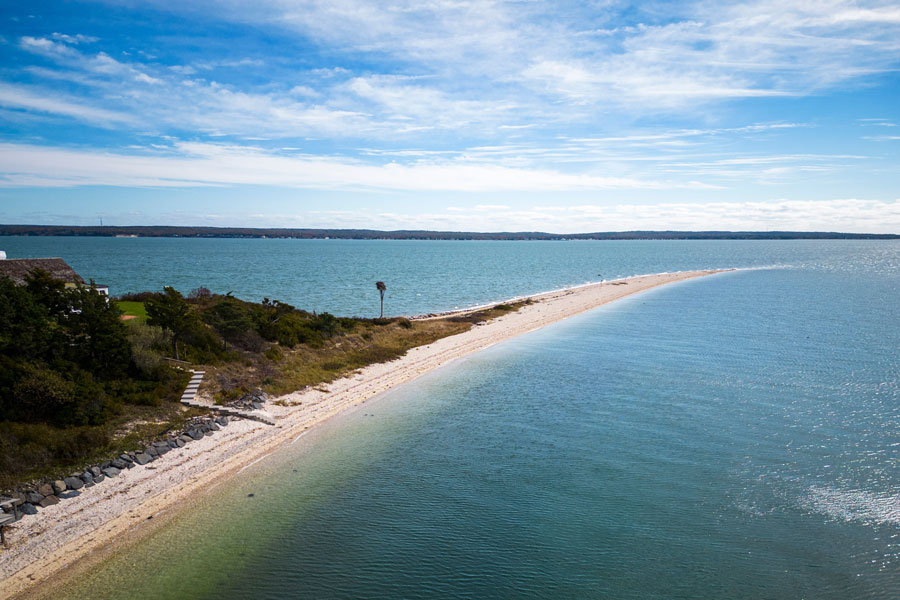Great Peconic Bay, Long Island

Great Peconic Bay sits at the center of eastern Long Island, stretching between the North and South Forks and forming the core of the Peconic Estuary system. Sheltered from the open Atlantic, its calm waters have sustained Indigenous tribes, fishing communities, and coastal towns for thousands of years. Today it remains one of the most important ecological and recreational waterways on Long Island – a bay where scallops once defined a regional economy, sailboats drift past sandy coves, and conservation efforts continue to shape the future of the East End.
Location & Geography
Great Peconic Bay lies between the Towns of Southampton and Riverhead to the south and Southold and Shelter Island to the north. The bay is fed by a series of creeks, tidal rivers, and the wider Peconic Estuary, eventually opening into Little Peconic Bay and Gardiners Bay to the east. It is bordered by coastal communities including:
- Hampton Bays
- Flanders
- Jamesport
- South Jamesport
- Aquebogue
- Riverhead
- Southold
Because it is protected by the Twin Forks landmass, the bay is generally calm and navigable – ideal for boating, fishing, kayaking, and sailing.
History & Cultural Significance
The Peconic region takes its name from the Algonquian word “Peconic,” traditionally interpreted as “nut trees” or “place of small hills.” The Shinnecock and Montaukett tribes lived along these shores long before European settlement, relying on the bay’s shellfish, finfish, and protected waters.
Through the 20th century, Great Peconic Bay became a celebrated center of scallop harvesting. The Peconic Bay scallop was once a symbol of Long Island seafood, served in restaurants throughout the Northeast. Although environmental changes and brown tide events devastated the fishery in the late 20th century, restoration programs are working to bring shellfish populations back. Today, baymen, charter captains, and conservation scientists treat the bay with a mix of reverence and urgency – all hoping to see the scallop fishery recover.
Recreation & Waterfront Access
Great Peconic Bay is popular with residents, vacationers, and boaters because of its calm water and scenic shoreline. Some of the most commonly used access points include:
- Meschutt Beach County Park
- South Jamesport Beach
- Iron Pier Beach in Northville
- New Suffolk Beach (across Little Peconic Bay)
- Public boat ramps in Riverhead and Hampton Bays
- Local marina facilities and yacht clubs
Fishing, sailing, clamming, paddleboarding, and sunset cruises are everyday activities here, especially during the summer season.
Wildlife & Ecology
The bay is part of the Peconic Estuary Reserve, one of the most biologically significant estuaries in the Northeast. Its shallow waters support:
- Shellfish including scallops, clams, and oysters
- Horseshoe crabs and blue claw crabs
- Striped bass, bluefish, porgies, weakfish, and fluke
- Osprey, egrets, terns, and migratory birds
- Eelgrass beds and marsh habitats
Large portions of the surrounding land are protected or managed for ecological resilience, and ongoing research focuses on water quality, habitat loss, and shellfish restoration.
Environmental Challenges & Restoration Efforts
Like other Long Island bays, Great Peconic Bay has been affected by nitrogen pollution, algae blooms, and habitat loss. However, it is also the focus of major environmental rehabilitation programs, including:
- Shellfish seeding and scallop restoration
- Eelgrass planting and habitat restoration
- Stormwater and septic improvement initiatives
- Long-term water quality monitoring through the Peconic Estuary Partnership (PEP)
Local shellfish hatcheries and marine labs (including Stony Brook University) play a major role in these efforts.
Key Facts
| Feature | Details |
|---|---|
| Location | Between the North & South Forks, Eastern Long Island |
| Primary Towns | Southampton, Riverhead, Southold |
| Water Body Type | Tidal bay, estuary |
| Connected To | Little Peconic Bay, Gardiners Bay, Peconic River |
| Notable Access Points | Meschutt, South Jamesport, Iron Pier |
| Ecological Status | Part of the Peconic Estuary Reserve |
| Known For | Scallops, boating, calm waters, conservation |
Great Peconic Bay is more than a scenic body of water – it is the geographic and ecological heart of the East End. Its shores tell the story of Indigenous history, maritime tradition, environmental challenge, and scientific resilience. Whether you’re launching a boat from Jamesport, watching the sun dip behind Flanders Bay, or sampling local scallops in season, Great Peconic Bay remains one of Long Island’s most defining and cherished coastal environments.

